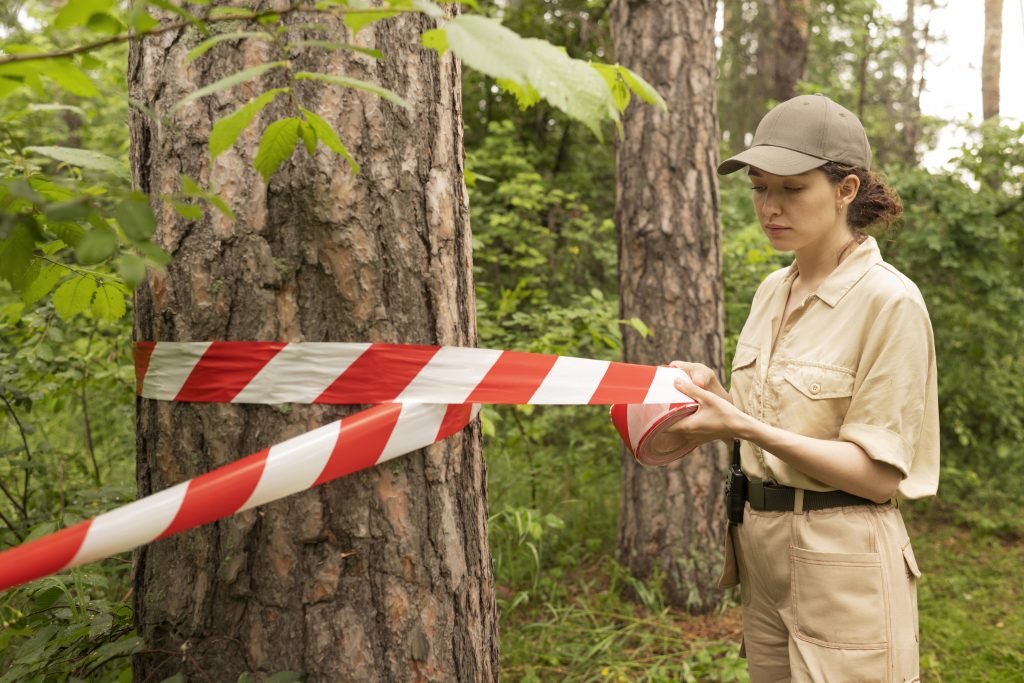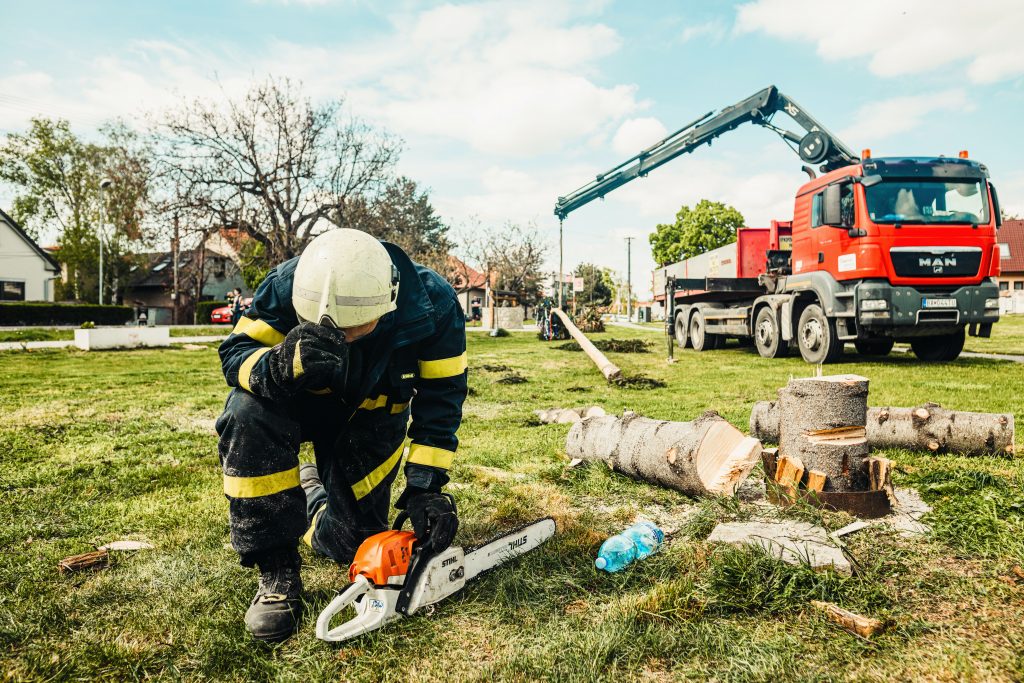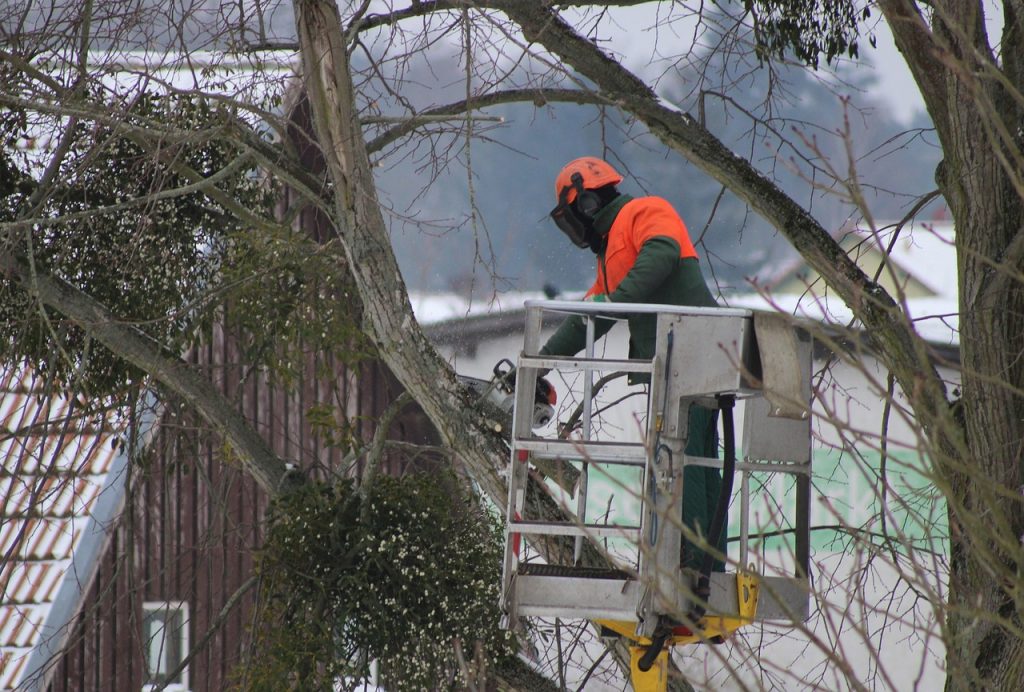DIY tree removal, also known as “Do-It-Yourself” tree removal, refers to the practice of homeowners or individuals attempting to remove trees from their property without the assistance or expertise of professional arborists or tree removal services. This approach involves using basic tools, equipment, and personal knowledge to fell, cut, and remove trees without proper training or understanding of the complexities and risks associated with tree removal.

While some people choose to undertake DIY tree removal to save money or engage in a hands-on outdoor project, it’s important to recognize that tree removal is a complex task that requires a deep understanding of tree biology, proper cutting techniques, safety procedures, and the use of specialized tools. Without the proper expertise, DIY tree removal can pose serious dangers to both individuals and property.
Common steps involved in DIY tree removal include assessing the tree’s condition, selecting the cutting points, making cuts to control the direction of fall, and finally, cutting the tree into manageable pieces for disposal. However, each of these steps requires careful consideration, as trees can be unpredictable in their behavior, and factors such as the tree’s height, weight distribution, wind direction, and surrounding obstacles can greatly influence the process.
Despite the potential risks and challenges, some homeowners still choose to attempt DIY tree removal due to various reasons, including a lack of awareness about the dangers involved, overestimation of personal skills, or a desire to save money. However, the potential consequences of DIY tree removal gone wrong can range from personal injuries and property damage to legal liabilities and negative ecological impacts.
In many cases, it is strongly recommended to seek the services of certified arborists or professional tree removal companies when dealing with tree removal, especially if the tree is large, close to structures or utility lines, or situated in a densely populated area. Arborists have the necessary training, experience, and equipment to safely assess the tree’s condition, plan the removal process, and carry out the task with minimal risk to people and property.
The Do-It-Yourself (DIY) approach involves individuals taking on tasks and projects on their own, without seeking professional help or hiring experts. It’s a popular trend where people choose to rely on their own skills, knowledge, and resources to complete various tasks, rather than outsourcing them to professionals. This approach can be seen in a wide range of activities, from home repairs and renovations to crafting, gardening, and even tree removal.
In the context of tree removal, the DIY approach refers to homeowners attempting to remove trees from their property without the involvement of professional arborists or tree removal services. This trend has gained popularity for several reasons:

1. Cost Savings: One of the primary reasons homeowners opt for the DIY approach to tree removal is the desire to save money. Professional tree removal services can sometimes be expensive, especially for larger trees or complex removals. By choosing to do it themselves, homeowners can avoid these costs.
2. Personal Satisfaction: Many individuals find a sense of accomplishment and personal satisfaction in completing challenging tasks on their own. DIY tree removal can provide a hands-on outdoor project that allows homeowners to interact with nature and their surroundings.
3. Control and Flexibility: When homeowners take on the task themselves, they have full control over the process. They can decide when and how the tree will be removed, and they can tailor the process to their preferences.
4. Learning Experience: DIY tree removal offers the opportunity to learn new skills and gain knowledge about tree anatomy, cutting techniques, and safety procedures. Some homeowners are motivated by the desire to expand their knowledge and abilities.
5. Lack of Awareness: In some cases, homeowners might not be fully aware of the risks and complexities involved in tree removal. They might underestimate the potential dangers and challenges, leading them to believe that DIY is a feasible option.
However, it’s important to note that while the DIY approach has its merits, tree removal is a task that requires specialized knowledge and equipment. The growing trend of homeowners attempting tree removal can also come with several significant drawbacks and dangers:
1. Safety Risks: Tree removal involves working at heights, using tools such as chainsaws, and dealing with heavy branches. Without proper training and safety equipment, individuals are at a higher risk of accidents and injuries.
2. Lack of Expertise: Trees have complex growth patterns, and their behavior can be unpredictable during removal. Without understanding tree anatomy and the dynamics of falling branches, there’s a risk of improper cuts leading to unexpected tree behavior.
3. Property Damage: Inaccurate cuts, falling branches, or trees toppling in the wrong direction can cause extensive damage to structures, vehicles, utility lines, and neighboring properties.
4. Ecological Impact: Removing trees without proper knowledge can have negative ecological consequences, including disruption of ecosystems, soil erosion, and loss of habitat for wildlife.
5. Legal and Insurance Issues: DIY tree removal gone wrong can lead to legal liabilities if it causes damage to property or injuries. Insurance coverage might also be limited in cases of accidents resulting from unskilled tree removal.
As the trend of homeowners attempting tree removal continues, it’s crucial for individuals to educate themselves about the risks involved and consider seeking professional help from certified arborists or tree removal services to ensure safe and responsible tree management.
Understanding the dangers involved in DIY tree removal is crucial for the safety of individuals, protection of property, and the preservation of the environment. Failing to recognize and respect these dangers can lead to serious consequences. Here’s why understanding these dangers is so important:

1. Personal Safety: Tree removal involves working at heights, using sharp tools like chainsaws, and handling heavy branches. Without proper training and safety equipment, individuals are at a high risk of accidents, including falls, cuts, and other injuries. Understanding these risks can help homeowners prioritize their own safety and the safety of those around them.
2. Inadequate Knowledge: Trees are complex living organisms with specific growth patterns and behaviors. Without a deep understanding of tree anatomy, potential hazards, and proper cutting techniques, DIY tree removers may inadvertently make mistakes that lead to falling branches or trees behaving unpredictably.
3. Property Damage: Trees, especially large ones, can cause significant damage to property if not removed correctly. Falling branches or trees can damage structures, vehicles, utility lines, and neighboring properties. Recognizing the potential for property damage underscores the need for professional expertise.
4. Unpredictable Behavior: Trees can react differently during removal based on their species, health, and environmental factors. An individual without proper training might misjudge how a tree will fall or underestimate the force with which branches can swing, leading to dangerous situations.
5. Legal and Liability Issues: Attempting tree removal without adequate expertise can lead to legal liabilities if it results in damage to property, injuries to individuals, or even environmental harm. Understanding these potential legal and financial consequences is essential.
6. Insurance Limitations: Homeowner’s insurance might not cover damages or injuries resulting from unskilled tree removal. Homeowners who fail to grasp this limitation could face unexpected financial burdens if accidents occur.
7. Ecological Impact: Trees play a vital role in the ecosystem by providing habitat for wildlife, stabilizing soil, and contributing to air quality. Removing trees without proper knowledge can disrupt these ecological functions and lead to negative consequences for the environment.
8. Emergency Situations: DIY tree removal attempts can quickly turn into emergency situations if something goes wrong. Individuals might find themselves trapped under fallen branches or in other dangerous scenarios, requiring immediate professional intervention.
9. Professional Expertise: Understanding the dangers can highlight the value of professional arborists. Certified arborists possess the necessary skills, knowledge, and equipment to safely assess tree health, plan removals, and execute the process with minimal risk.
10. Alternative Solutions: Recognizing the dangers can lead homeowners to consider alternative solutions such as hiring professionals for tree removal or other safer DIY activities like tree pruning and maintenance.
In conclusion, comprehending the dangers involved in DIY tree removal is crucial for making informed decisions that prioritize safety, property protection, and environmental conservation. By acknowledging these risks, individuals are more likely to seek professional help when needed and make choices that promote the well-being of themselves, their property, and the surrounding environment.
DIY tree removal poses a range of safety hazards due to the complex nature of the task and the lack of proper training and equipment. Engaging in tree removal without professional expertise can lead to serious accidents and injuries. Here are some safety hazards associated with DIY tree removal:
1. Working at Heights: Tree removal often requires working at considerable heights, such as climbing ladders or using elevated platforms. Without proper training and equipment like harnesses and safety lines, individuals are at risk of falling, which can result in severe injuries or even fatalities.
2. Falling Branches: Tree branches, especially those from large trees, can weigh hundreds of pounds. Cutting branches without proper support or control can cause them to fall unexpectedly and injure individuals below. Even smaller branches can cause harm if they fall from a height.
3. Improper Tool Use: Chainsaws and other cutting tools are essential for tree removal, but they can be extremely dangerous if not used correctly. Inadequate knowledge of how to handle these tools can result in cuts, lacerations, and amputations.
4. Incorrect Cutting Techniques: Trees need to be carefully cut to control their falling direction. Incorrect cutting angles or depths can lead to trees falling in unexpected directions, posing risks to individuals, property, and neighboring structures.
5. Lack of Protective Gear: Personal protective equipment (PPE), such as helmets, eye protection, gloves, and sturdy clothing, is essential when working with trees and tools. Not wearing appropriate PPE increases the risk of injuries.
6. Unstable Tree Structure: DIY tree removers might not have the expertise to identify signs of tree instability or decay. Cutting into a compromised tree can lead to sudden collapse or the release of tension, causing branches or the trunk to snap unexpectedly.
7. Electrocution: Trees can be in close proximity to power lines. Cutting branches near power lines without proper knowledge and precautions can result in electric shock or electrocution.
8. Entanglement: Climbing trees or working in them can lead to situations where individuals become entangled in branches or equipment, making it difficult to move or descend safely.
9. Inadequate Planning: Proper planning is essential for safe tree removal. DIY attempts might lack a comprehensive understanding of the tree’s condition, surrounding structures, and potential hazards, leading to accidents.
10. Emergency Situations: When something goes wrong during DIY tree removal, it can quickly escalate into an emergency situation. Individuals might find themselves stuck in trees, pinned under branches, or facing other life-threatening scenarios.
11. Environmental Factors: Weather conditions like wind, rain, or even extreme heat can impact the safety of DIY tree removal. These factors can affect the stability of the tree, the behavior of branches, and the overall safety of the removal process.
Given these safety hazards, it’s strongly recommended that individuals with limited or no experience in tree removal seek the assistance of certified arborists or professional tree removal services. These experts have the training, experience, and equipment to assess risks, plan removals, and execute them safely. Prioritizing safety over cost or convenience is crucial to preventing accidents, injuries, and property damage during tree removal activities.
Murray is a city situated on the Wasatch Front in the core of Salt Lake Valley in the U.S. state of Utah. Named for territorial governor Eli Murray, it is the state's fourteenth largest city. According to the 2020 census, Murray had a population of 50,637. Murray shares borders with Taylorsville, Holladay, South Salt Lake and West Jordan, Utah. Once teeming with heavy industry, Murray's industrial sector now has little trace and has been replaced by major mercantile sectors. Known for its central location in Salt Lake County, Murray has been called the Hub of Salt Lake County. Unlike most of its neighboring communities, Murray operates its own police, fire, power, water, library, and parks and recreation departments and has its own school district. While maintaining many of its own services, Murray has one of the lowest city tax rates in the state.
Murray Oakes, Grant Park, Southwood Park, Murray Park, Murray Park Restrooms, Willow Pond Park, Neighborhood Veterinary Care
We had a great experience with TruCo! They were well priced, responsive and prompt. Michael was a pleasure to work with and gave us advice on which plants to put in where we took out our ugly old shrubs. I would highly recommend this company!!!
TruCo Services gets 5 stars from us for customer service. We experienced a few issues with their services this last year and Rob Eccles in senior management, stepped in and immediately handled our issues. He was very committed to making sure they understood our expectations and would execute to make us happy.
I work for a property management company and have the pleasure of working with Rob at a community in Sandy. He has been incredible to work with and always responds in a timely manner. He knows all the homeowners by name and address and is aware of all the "problem" areas when it comes to sprinklers. I never have to worry about following up with him because he always reaches out to provide me with an update. If you're looking to work with someone who takes pride in their job, is professional, and can solve the worst landscaping problems thrown your way, Rob is your guy. Thank you, Rob for all you do!
We have used Truco at 2 of the complexes we manage, they have been great to work with. Good quality service, outstanding customer service with good communication. That's hard to find these days. I highly recommend them. Travis has been awesome to work with.
We use TruCo for a majority of our properties and our home. While other landscaping companies we use come and go for various reasons like cost, communication issues, work performance, etc., TruCo is always consistent in price and work. Also, Rob is the best.